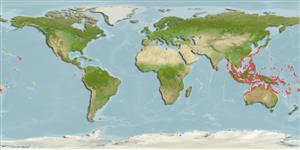Holothuroidea |
Holothuriida |
Holothuriidae
Environment: milieu / climate zone / depth range / distribution range
Ecology
Reef-associated; depth range 3 - 16 m (Ref. 81020). Tropical
Indo-Pacific, excluding Hawaii.
Length at first maturity / Size / Weight / Age
Maturity: Lm ? range ? - ? cm Max length : 26.0 cm TL male/unsexed; (Ref. 122); common length : 18.0 cm TL male/unsexed; (Ref. 122); max. published weight: 800.00 g (Ref. 122)
Mean live weight, 300 to 800 g; body thickness 0.4 cm. Body cylindrical, flattened ventrally (trivium). Bivium smooth and rigid. Podia on bivium long, slender, conical, and irregularly arranged; podia on trivium more numerous, shorter and irregularly arranged on the radii and interradii; calcareous disc of podia around 400 micrometer in diameter. Mouth ventral, surrounded by 20 short tentacles. Anus nearly dorsal, surrounded by 5 groups of radial papillae. Calcareous ring with large radial pieces and narrow interradials having sharp tops. Cuvierian tubules long and large. Variable color among specimens and localities; bivium beige to light brown, showing characteristic brown spots; trivium lighter, yellowish. Spicules on ventral tegument with simple nodules with or without holes and sparse rods giving rise to rosettes; dorsal tegument with rosettes and small biscuit-like plates; ventral podia with variable rods; dorsal podia with x-shaped rods; tops of tentacles with spiny rods.
May be harvested along with other reef flat species, such as Holothuria scabra, when they occur together, but the sticky Cuvierian tubules make the collection and processing disagreeable; Collected by divers. Processed product is not distinguished from those of other Bohadschia species; little commercial value. Found in very shallow waters; occurs in coastal lagoons or inner reef flats, generally burrowing in sandy-muddy bottoms. Populations can reach densities of 0.03 per square meter. Biology poorly known (Ref. 122).
Life cycle and mating behavior
Maturity | Reproduction | Spawning | Eggs | Fecundity | Larvae
Conand, C. 1998 Holothurians (sea cucumbers, Class Holothuroidea). p. 1157-1190. In Carpenter, K.E. and V.H. Niem (eds.) FAO Species Identification Guide for Fishery Purposes. The Living Marine Resources of the Western Central Pacific. Vol. 2. Cephalopods, crustaceans, holothurians and sharks. FAO Rome. (Ref. 122)
IUCN Red List Status
(Ref. 130435: Version 2025-1)
CITES status (Ref. 108899)
Not Evaluated
Not Evaluated
Threat to humans
Harmless
Human uses
Fisheries: minor commercial
| FishSource |
Tools
More information
Trophic EcologyFood items (preys)
Diet composition
Food consumption
Predators
Life cycleReproduction
Maturity
Fecundity
Spawning
Eggs
Egg development
Larvae
PhysiologyOxygen consumption
Human RelatedStamps, coins, misc.
Internet sources
Estimates based on models
Preferred temperature
(Ref.
115969): 24.3 - 29.3, mean 28.6 (based on 3048 cells).
Fishing Vulnerability
Low vulnerability (16 of 100).
Price category
Unknown.
